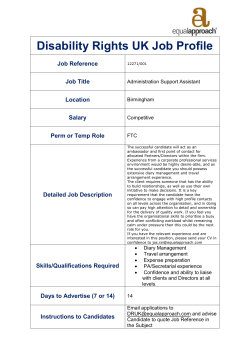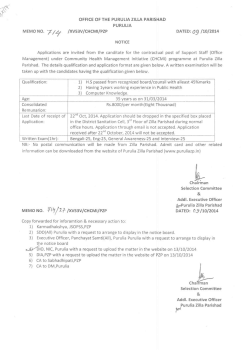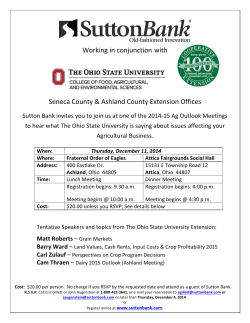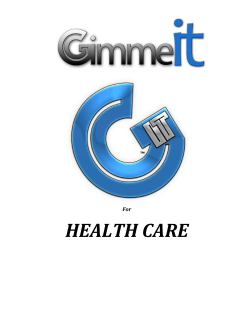
Newsletter - Spring 2015 - Ohio Association for Healthcare Quality
Quality Matters, S pring O h io ! 2015 Newsletter of Ohio Association for Healthcare Quality PUT TI NG ON E R RS “Three articles in this issue of the OAHQ newsletter come from the same source, Healthcare Performance Improvement, LLC (HPI). Founded in 2006, HPI is a consulting firm which guides organizations in comprehensive safety and reliability culture improvement. Their engagements include three phases – a diagnostic assessment phase, intervention implementation, and building accountability systems. For more information, visit www.hpiresults.com”. Written by Craig Clapper, PE, CMQ/OE, Healthcare Performance Improvement To err is human – to malfunction is left for devices. Dr Brent James, chief quality officer of Intermountain Healthcare based in Salt Lake City, observed that few harm events were caused by human error. Dr James’ observation was published as commentary in the 13 June 2011 issue of Modern Healthcare and is worthy of being quoted at length: … less than 5% of care-associated adverse events trace back to human error. The vast majority of such events result from predictable system failures. Using the term “error” to describe these events is a serious mistake. It focuses the mind, and the search for solutions, on the 5% subcategory, at the expense of the 95%. Can this be true? And if so, what does this say for all of us diligently working to prevent human error using non-technical skills to put our safety cultures to work? And adding more fuel to the controversy, a rebuttal now appears on Wikipedia discounting Heinrich’s law. Herbert William Heinrich was an American industrial safety pioneer from the 1930s. In 1931, he published a book that provided statistics that later became known as Heinrich’s law. From a review of thousands of accident reports, Heinrich concluded I n T his I ssue : page two: page six: page seven: President’s Update OAHQ 2015 Conference Registration Form Shirley M. Toepfert Award that for every accident that causes major injury, there are 29 accidents that cause minor injuries and 330 accidents that cause no injuries. He perceived that 88% of accidents were caused by “man-failure.” Heinrich’s 88-10-2 ratios indicate that among the proximate causes, 88 percent are unsafe acts, 10 percent are unsafe mechanical or physical conditions and 2 percent are unpreventable. The main evidence used against Heinrich’s law was from Dr. W Edwards Deming. In 1981, sales by the Ford Motor Company were falling. Between 1979 and 1982, Ford had incurred $3 billion in losses. Ford’s new division quality manager, John A Manoogian, engaged Dr. Deming to start a quality movement at Ford. Deming pointed to Ford’s culture and Ford’s leadership method. To Ford’s surprise, Deming talked not about quality but about leadership. He told Ford that management actions were responsible for 85% of all problems. Continued on page 4. Q u a l it y TODAY F rom T he P resident WOW! The winter weather is finally over, I hope! Those cold, frigid, temperatures and the snow too! Enjoy the change of the seasons. Sunshine, flowers, and gardens will be here soon, and so will the OAHQ conference. Mark your calendars! The OAHQ Annual Conference is May 14-15, 2015 at Embassy Suites, Airport, and the same location as previously. You may well recognize our speakers; they are always inspiring and engaging. Two favorites, Jim Conway and Sue Dill are returning. In addition, speakers include your colleagues and physicians from the Ohio Hospital Association and the Ohio Perinatal Quality Collaborative. New this year, we have added a bonus session for an additional CE, after the Thursday program concludes. Publication opportunities are available for our OAHQ Newsletter. Awards will be given for article submissions that are published in our Newsletter. Share your quality improvement stories. Submit articles for your newsletter, Quality Matters, OHIO! We all contribute to our professions in so many different ways, each having an impact. OAHQ is your organization. It represents what we are and is here to serve you, to inspire you professionally. We are committed to the quality healthcare Page 2 professional and promoting opportunities for certification. We continue to offer the highest level of educational opportunities to achieve the CPHQ designation. CPHQ education sessions will be scheduled for you during 2015. Remember the Board meetings are open for you to attend, should you choose. Contact any of the Board members for meeting information. The OAHQ website lists Board members contact information and the Board meeting schedule. We have currently expanded the Board membership to maintain geographical diversity. To be successful as an organization, we need you. Don’t forget to maintain your OAHQ membership. Please volunteer to support your organization. Opportunities are endless and are needed for Leadership, Board membership, conference planning, newsletter publications, and so much more. The future looks promising as we work together to achieve the goals we have set for the organization. Culture Change: A Real Pain in the ...Mouth? Written by Tiffany Obetts, RN, BSN, Healthcare Performance Improvement Consultant I recently had braces put on as an adult. As I sat there those first couple days with a very sensitive mouth, I couldn’t help but think of the work we do in safety and reliability culture change. It all starts with a great idea. You want to change something. You want to improve your smile, you want to improve your culture. You set forth with a plan! Braces for 9 months! Reliability Culture Implementation in 18 months! It’s hard at first. You feel tension start to creep in, there’s some pain and some activities that were once easy, get a little harder (like eating anything!). In our work, that might Continued on page 4. Remember, YOU are OAHQ. Please know it has been my pleasure to serve you once again as your OAHQ President. Enjoy the spring season. Support and remember our military troops and their families. Be Safe. Take care of one another. LIVE, LAUGH, LOVE. Warmest regards, B. Jody Ciccone Snyder, RN, BS, MPH, CPHQ 2015 OAHQ President Quality Matters, Ohio! Q u a l it y TOMOR ROW Saving Carol Decker Written by Craig Clapper, PE, CMQ/OE, Healthcare Performance Improvement Five days after the cesarean, one of her physicians said, “She might make it.” Not the words one would want to hear. Carol Decker did live and survive sepsis. Carol was discharged to home 97 days after her daughter’s birth in June 2008. To survive sepsis - she required amputations of both feet and the left hand, a tracheotomy, surgical removal of dead tissue on her abdomen, arms and back, and five rounds of skin grafts. And Carol also lost her sight – she has never seen her baby girl. Carol Decker, inset top with daughters Chloe and Safiya, is one of an estimated 750,000 cases of severe sepsis every year in the US. The mortality rate is 28-50% (compared to AMI at 2.79.6% and stroke at 9.3%). One patient dies every three minutes. (These data are from Surviving Sepsis Campaign: http://www. survivingsepsis.org/Background/ Pages/UnderstandingProgress. aspx.) Not all patient deaths caused by sepsis are harm. Not all sepsis outcomes with major losses of function are harm. Carol Decker’s case was likely harm – before delivering by cesarean in the middle of her ordeal, Carol had been to an emergency room, her OB physician’s office, and an OB unit of an acute care hospital. Someone could of or should of recognized her sepsis. This is Quality Matters, Ohio! likely a delay in treatment or diagnosis. 2. Teams need to think together in infrequent, complex, and time dependent work. These situations are highly prone to error. Resilience is the ability of the team to recognize when the team is off track – and think together to get back on track. Does our safety culture include behaviors for team thinking? And do we practice together in simulation to develop resilience? Infrequent, complex, and time dependent – three factors in a high reliability organization that indicate the need for a standard protocol and training on that protocol. The best method for training – simulation. Learning is doing with feedback. If there is no doing, there is no learning. If there is doing with no feedback, then we are learning something – but are we learning the right practice habits? Practice does not make perfect. Practice makes permanent. Debrief 3. Carol Decker also lost her simulations – and ring finger on her everyday patient right hand. No one care – to ensure that removed the ring on “Infrequent, complex, that finger – and the we are learning the and time dependent swelling resulted in right practice habits. – three factors in a loss of circulation. Questions to a high reliability This is a small lesson Consider: organization that in attention to detail indicate the need for (only small when 1. Most people a standard protocol compared to the overestimate and training on that horror of Carol’s their protocol.” overall issues). How performance are our people doing under pressure. in attention to detail? We do not rise And do we as leaders even to the occasion – we fall know through our rounding back to the level of our activities? Perhaps this training. So, how are we should be the focus of our as safety leaders doing leader safety rounds this in training our people on week. infrequent, complex, and time dependent protocols? This and other insights of HPI Do we have a focused and team members can be found simplified protocol? With at http://hpiresults.com/index. role clarity? And trained in php/insight. simulation? Page 3 Q u a l it y C ounts Continued from page 1. The attack on Heinrich’s law is based on Deming’s 85% - and could also be based on James’ 95%. Both assert that human error is not the cause of problems - and both are right. Systems cause human error (and systems also cause device malfunctions and failures). People merely experience error. A good way to say this is – human error is the proximate cause of harm (occurring at the sharp end of the system) and systems error is the distal cause of harm (occurring at the blunt end of the system). Deep recurrence control only happens when distal causes are corrected. However, we at HPI maintain that while systems cause all human error and device malfunctions/failures, people are resilient (because they can think and they care about patients) and can prevent most of the errors using non-technical skills. Based on a study of harm in 96 hospitals over two years, 74.5% of the acts leading to serious harm could be prevented using safety culture with non-technical skills. There were 1,964 cases of serious harm in the study and 4,614 acts leading to the cases of harm. (And we also find that greater than 90% of the proximate causes leading to serious harm are acts of people (human error), leaving less than 10% for device and equipment failures and malfunctions.) Questions to consider: 1. Do we view human error as the starting point of our cause analysis to prevent recurrence or the end point of our analysis? 2. Are we careful to say “systems cause error” and “people experience error” to avoid casting blame? Page 4 Continued from page 2. be when the Serious Safety Event Rate (SSER) starts to rise, difficult conversations start occurring, or standing up in front of the hospital board sharing your harm events. performed consistently over time. I wasn’t reliable in the very thing that would sustain my change. Eventually, the retainer no longer fit and my teeth started to move back. But, you keep at it. In time, it gets a little easier and the pain may subside. Then, it’s time to get that new wire placed (in 6 weeks for me, could be 6 months for you). This may be a turning point in your culture: you start getting tougher on classification, you need to make decisions on resourcing important activities such as safety coaches or expanding your cause analysis program – the pain creeps back in again, but you stick to it – the popular saying goes, “no pain, no gain”. That’s the same thing with our culture work! We have to have strong reinforcement and accountability loops so we don’t lose the gains! Otherwise, our previous pain and discomfort was all for naught. After all, you are improving something much more significant than a smile. You are on a mission to save lives. And what about those gains? See, I didn’t mention before that I had braces once when I was 15. I remember the initial pain and the satisfaction the day the braces came off and how beautiful my smile was! However, the reinforcement of wearing my retainer wasn’t 3. Are we proficient in fixing the systems causes of human error? Or, do we tend to try fixes for the proximate causes? 4. Do we use our safety culture and non-technical skills as an additional level of patient protection in preventing human error? Or do we use only one – the system fix or relying on people to prevent? This and other insights of HPI team members can be found at http:// hpiresults.com/index.php/insight. Consider these questions: 1. When you imagine the potential beauty of your “safety culture smile”, what do you see? What are the steps you will need to take to get there? 2. When the journey gets painful, what are you going to do to ensure you continue to move forward and not go back to those crooked teeth? Ohio Association for Healthcare Quality 2015 Board of Directors President Jody Ciccone-Snyder President-Elect Marsha Jevas Past President Susan Butler Treasurer Patti Klingel Committees Conference Membership Continuing Ed Members at Large Jody Ciccone-Snyder Marsha Jevas Laurel Dolejs Theresa Wnek Marsha Jevas Nancy Terwoord Newsletter Editor Designer Sandy Macovei Laura O’Neill Quality Matters, Ohio! 2015 OAHQ Conference May 14-15 OAHQ Member Call for Newsletter Articles – Fall 2015 THE PRIZE COULD BE YOURS! Upon finalizing this Spring issue of the OAHQ Newsletter, the Committee has already begun looking ahead to the 2015 Fall issue. We would like to tap into the knowledge, expertise, and meaningful activities related to quality and process improvement that we know are ongoing within our membership in your respective places of work. As we consider topics for the next newsletter, we are offering the following opportunity to OAHQ members: if you submit an article and it is published in the Newsletter, you will receive a $25 gift card. Please consider submitting an article or blurb that touts the great work of you or your team. We would be particularly interested to learn about initiatives related to improving readmission rates, as that will be the theme of the next issue, but are open to considering other topics as well. Thank you for considering! The deadline to submit your article is October 1, 2015. Please submit it to Sandy Macovei at smacovei@humana.com. You can also call Sandy at 513-5616617 with any questions. Quality Matters, Ohio! 2015 CONFERENCE TEASERS FROM OUR PRESENTERS • Jim Conway, Adjunct Faculty, Harvard T.H. Chan School of Public Health,”Profound learning across my almost 50 year career in healthcare; the most important things I’ve learned. This is lots about leadership, quality, safety, and patient and family centered care and is anchored of course in the notion that “experience is the name we give to our mistakes.” • Jeff Biehl, President, Healthcare Collaborative, Columbus, Ohio, “ We have designed a 90 minute session that teaches consumers how to use questions to improve the quality of their healthcare at a lower cost. We call it Patient Engagement Education & Training.” • Sue Dill Calloway RN Esq., President, Patient Safety and Healthcare Consulting and Education, “CMS data also show a high number of deficiencies for QAPI, as CMS rewrote all the QAPI standards March 21, 2014”. • Catherine Munn, MPH RHIA CPHQ, Sr. Consultant, “more news regarding quality and ICD-10 as we continue to move forward.” • Edward Skompski, Vice President, System Improvements, “ The Joint Commission has recognized TapRoot as an approach to root cause analysis for comprehensive System Analysis”. • The Ohio Hospital Association and the Ohio Perinatal Quality Collaborative, “Improving Ohio’s’ Infant Mortality Rate; A Story of Collaboration. This is an overview of health disparity, scientific approach in the area of prematurity and progesterone, an overview of multiple organization collaboration”. OAHQ Conference Brochures Available Soon! Page 5 C onference : C rossroads “Crossroads of Quality” Registration STATE CONFERENCE May 14 & 15, 2015 of Q ualit y REGISTRATION FEES 2-Days 1-Day OAHQ Member* $295 *Early Bird by 3/31/15 $270 Non-Member $190 $395$300 Includes breakfast, breaks and lunch. Name Title Address City/State/Zip Business Affiliation Email (work) ( ) (home) () Phone (work) ( ) (home) () Please complete for CEU records: Special Meal Requirements: □ RN □ LPN □ CPHQ □ CCM □ Vegetarian □ Other dietary needs: Registration Days (Please Check) □ *Member Early Bird by 3/31/15$270.00 □ Member Rate - Thursday Only $190.00 □ Member Rate - Friday Only $190.00 □ Non-Member Rate - Both Days $395.00 □ Non-Member Rate - Thursday Only $300.00 □ Non-Member Rate - Friday Only $300.00 □ Payment * Member Rate - Both Days $295.00• • Check made payable to Ohio Association for Healthcare Quality Credit Card (MasterCard or VISA) Account # Exp. Date Amount $ Receipt and registration confirmation sent by email. Mail to: OAHQ, P. O. Box 461045, Cleveland, OH 44146 Fax:330-468-1014 Questions? OAHQ@windstream.net REFUNDS Refunds until April 15, 2015 less a $25 processing fee. No refunds after April 15, 2015. Substitutions accepted. EXHIBITORS Please stop and visit all of our exhibitors and thank them for supporting OAHQ. Their support is essential to our conference. Page 6 Quality Matters, Ohio! Shirley M. Toepfert Distinguished Member Award PURPOSE The Shirley M. Toepfert distinguished member Award was developed to recognize an OAHQ member for his/ her outstanding contributions to the Ohio Association for Healthcare Quality. ELIGIBILITY Eligible candidates include any OAHQ member in good standing. SELECTION CRITERIA Each category will be scored on a 0-5 scale (0=not met; 5= strongly met). A total score of 25 is possible, but a minimum score of 15 is required for the award to be granted each year. LEADERSHIP • Candidate has been an officer, team leader and/ or member at a national or state level. • Candidate has been a presenter, co-presenter, or instructor at a national or state workshop, seminar or conference. • Candidate has demonstrated ability to facilitate growth and increase membership RECRUITMENT SUPPORT • Candidate actively promoted membership and participation by fellow healthcare management Quality Matters, Ohio! • Candidate maintains annual membership in OAHQ and NAHQ. • Candidate participates in OAHQ Speaker’s Bureau. • Candidate is consistently available and willing to volunteer time in nontraditional leadership roles in support of OAHQ functions (i.e. mailings, registration, phone calls, etc.) PUBLICATIONS/PRESENTATIONS • Candidate has had publication in professional journal(s) related to healthcare management field. • Candidate has consistently contributed articles to the OAHQ newsletter. • Candidate has had poster presentation at either state or national meeting. EDUCATION • Candidate has sought and/or completed further degree educational opportunities related to healthcare management. • Candidate has successfully completed the CPHQ certification. • Candidate has provided consultative services, either voluntary or paid, in healthcare management to other Ohio facility. Candidate is recognized as a resource person in area of consultation. PERFORMANCE IMPROVEMENT INITIATIVES • Candidate is recognized for developing and implementing Performance Improvement initiatives facility or organization that have demonstrated improvement in health care deliver, maintenance, physician organizations, customer satisfaction, critical pathways/practice. NOMINATION Nomination forms available from any member of the OAHQ Board of Directors. All nomination forms must be submitted by April 15 of each year. The OAHQ Board will select the recipient of the Shirley M. Toepfert Distinguished Member Award based on the criteria outlined in this policy. The recipient will be announced at the OAHQ Annual Education Conference held each year. AWARD The recipient will receive a personalized plaque, one year’s free OAHQ membership, one paid attendance to the Annual OAHQ Education Conference, a feature article in the OAHQ newsletter and a local newspaper identified by the recipient and a letter to the recipient’s employer. Continued on page 8. Page 7 Shirley M. Toepfert Distinguished Member Award Continued from page 7. SHIRLEY M. TOEPFERT DISTINGUISHED MEMBER AWARD - NOMINATION FORM Nominee’s Name: Title: Organization: Address: City: State: Phone: () Home Address: City: Cell: () State: Email Address: Zip: Zip: Current OAHQ Member? Yes No Person Nominating Candidate: Current NAHQ Member? Yes No CPHQ Certified? Yes No Relationship to Candidate: Your Address & Phone: Why do you believe this candidate should be selected as the recipient of the Shirley M. Toepfert Distinguished Member Award? (Use additional paper if more room is needed) Can you provide the name(s) of one other person(s) who would support this nomination? Name: Address: Work Phone: Home Phone: Signature: Date: Mail Nomination to: OAHQ, P.O. Box 461045, Cleveland, Ohio 44146-1045. Page 8 Formulated: 8/1995; Revised: 11/1999, 2/2001 Quality Matters, Ohio!
© Copyright 2025









